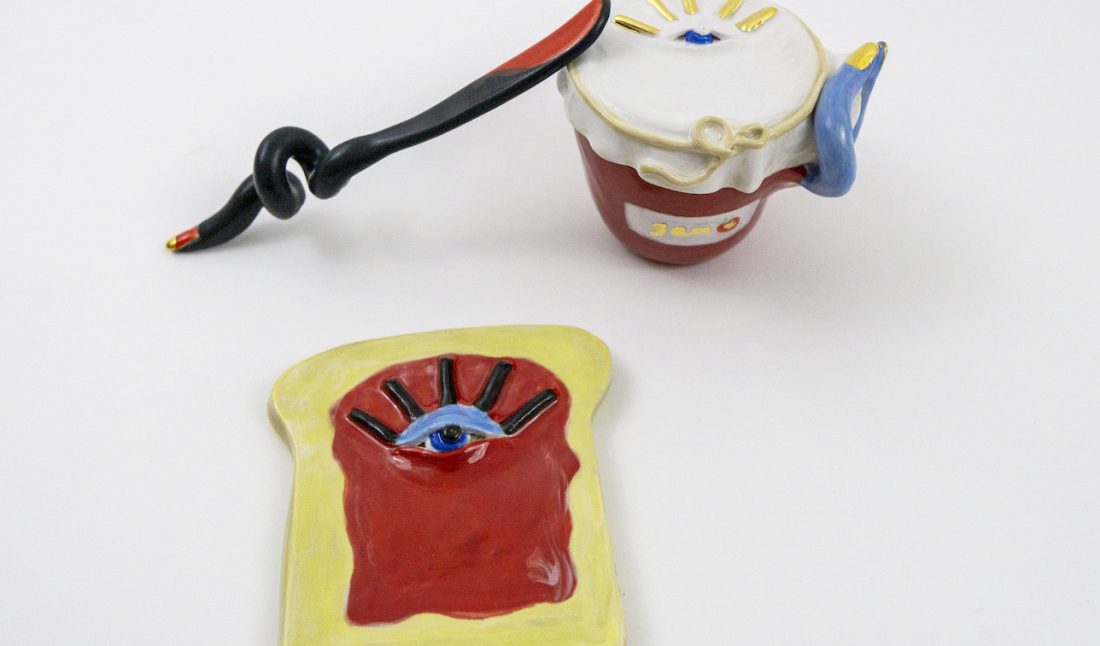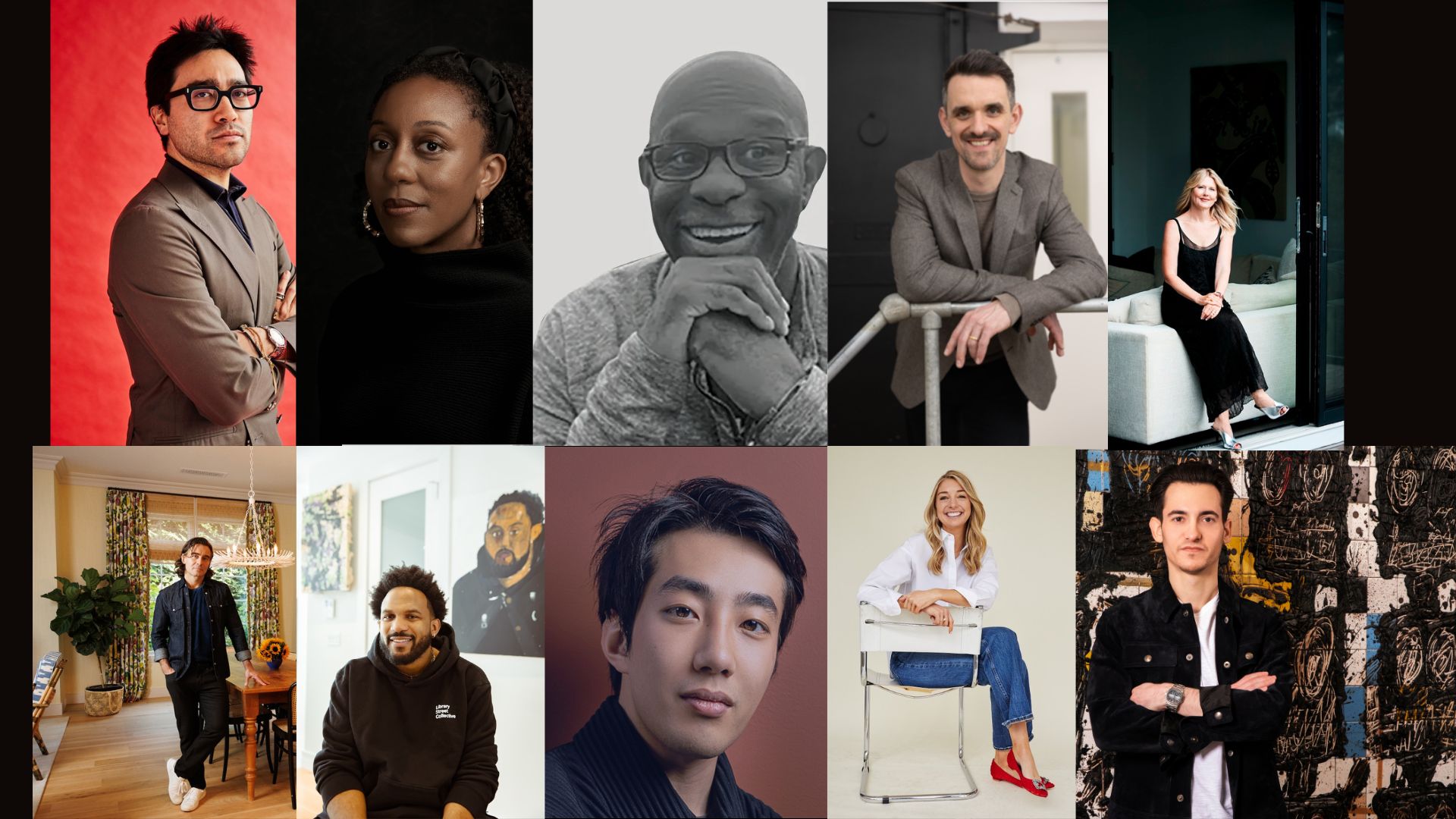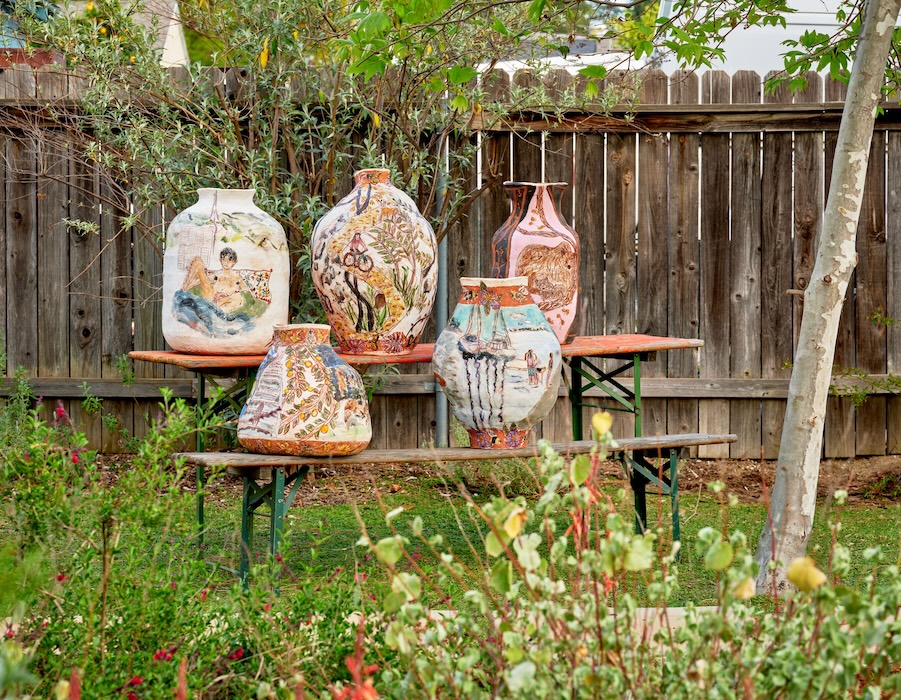Jen Dwyer’s solo exhibition, “Garden of Archetypes” at Dinner Gallery in New York was on view this spring, March 10—April 23. The new paintings and sculptures revealed the story of a female character, in her own private world, as she prepares herself to enter the public sphere. Viewers were welcomed by a likeness of contemporary culture, but drawn in further by a celebration of the one-of-a-kind, intricate self.
The artist established an enchanting depiction of the rituals of daily life, sacred memories, and lived experiences, veiled behind curtains. Inspired by ancient male and female archetypes, Rococo style, surrealism, and the modern routines and standards of beauty and fashion, Dwyer confronted the duplexity of adulthood. She asked the questions, who are we when confronted with others? where does our private life end and our public life begin?
Intrigued by the artist’s examination of the ebb and flow of taste and the influence of the tastemaker, Whitewall had the opportunity to ask the artist about her personal relationship to the history of cultural conformity and the unique ways in which her art suggests that we all hold the key to a splendid, private world of our own imagination.
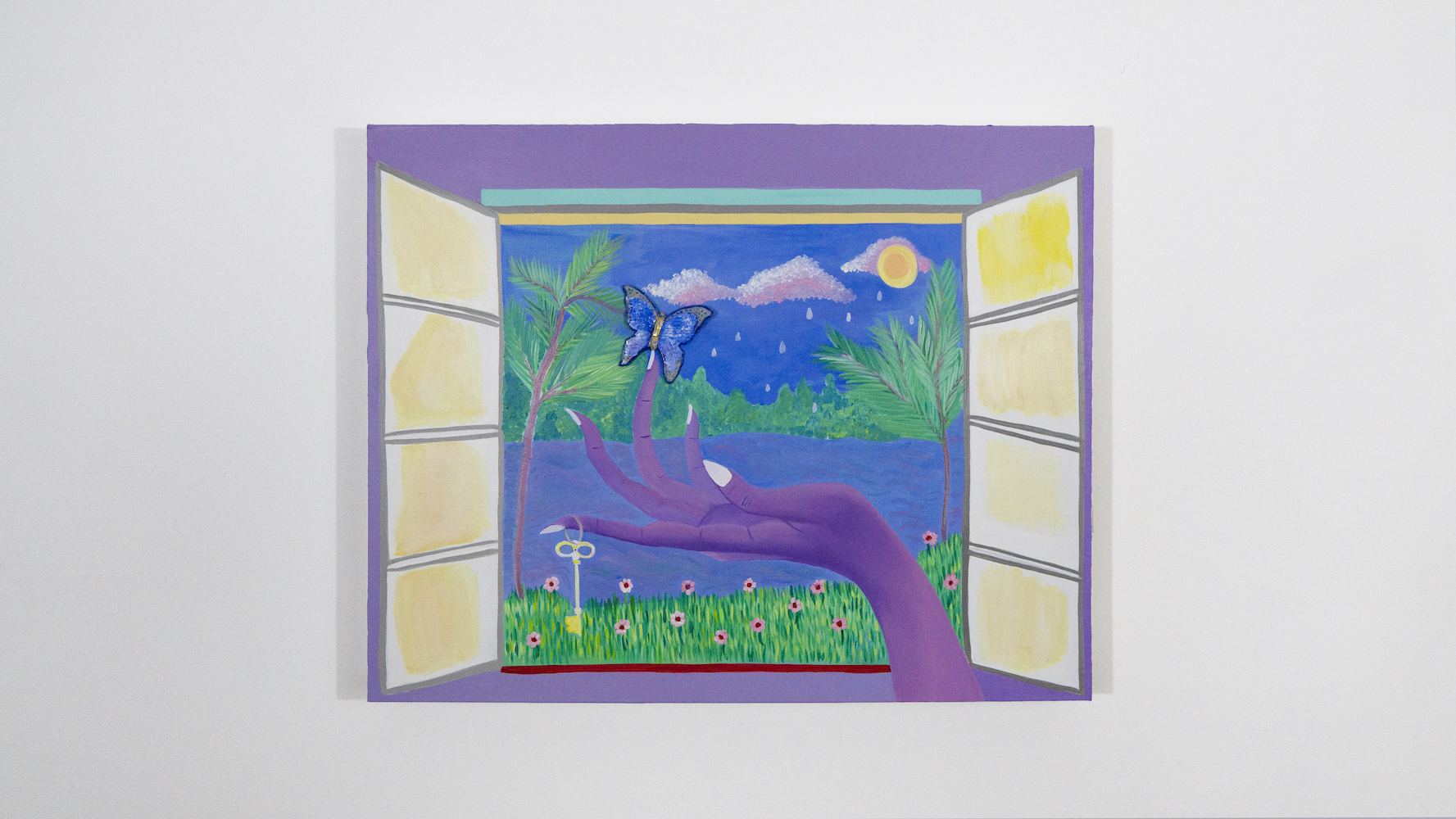 Jen Dwyer, “A Version Of A Wish,” 2021, 24 x 30 x 2 in, oil paint, acrylic paint, ceramics, glaze & 24 k gold luster on canvas; courtesy of the artist and Dinner Gallery, New York.
Jen Dwyer, “A Version Of A Wish,” 2021, 24 x 30 x 2 in, oil paint, acrylic paint, ceramics, glaze & 24 k gold luster on canvas; courtesy of the artist and Dinner Gallery, New York.
WHITEWALL: What was the starting point for “Garden of Archetypes”?
JEN DWYER: I’ve always been interested in human desire; I find what drives passion and the need to have something fascinating. Whether it’s a strong craving for a person, a career, style, place to live, specific food, or body type, I think about what we like and why we like it and how those proclivities are shaped, to be intriguing questions. Growing up in the 90s when magazines were so prevalent, I would flip through glossy pages and have such a strong desire to have the article of clothing that someone was wearing, the food they were eating, or to look just like them. I think about the ways that advertising convinces us we need something to be so compelling.
Later, in graduate school, I took a deeper dive into art history and came across a similar voyeuristic depiction of women in painting and sculpture, as seen in contemporary advertising. These voyeuristic pictures were showing us beautiful, idealized women in paintings or sculptures, but similar to advertising, all the pictures of women seemed to be there for our viewing pleasure. So I was interested in creating a narrative for these women as well as depicting them in a celebratory manner.
When I took a deeper dive into researching the history of ceramics, I came across these paleolithic figurines; the Venus of Willendorf is the most iconic although there are hundreds of them. According to a more recent theory, these sculptures were thought to be sculpted by the women themselves, so I liken them to the original female self-portrait. Which, particularly in comparison to the voyeuristic pictures we see of women in contemporary advertising and art history, can be seen as an act of agency.
Anyway, long story short, my exhibition, came about when I was offered this amazing opportunity to have my first solo show in Manhattan and I wanted to create a space for a woman’s narrative, that focused on her interests, wants, needs, and desires, rather than just a pretty picture of women for us to look at.
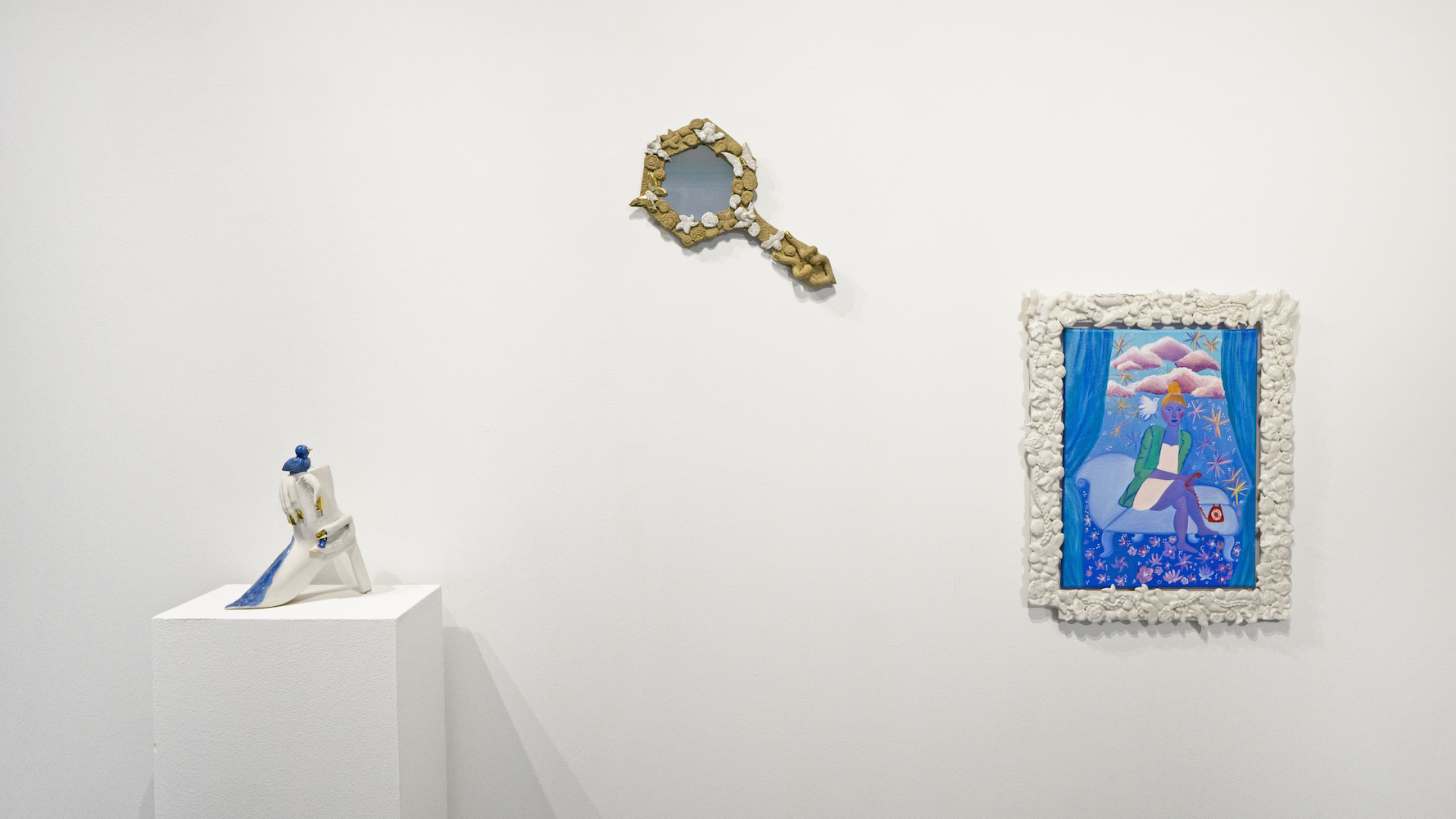 Installation view of Jen Dwyer’s “Garden of Archetypes,” courtesy of the artist and Dinner Gallery, New York.
Installation view of Jen Dwyer’s “Garden of Archetypes,” courtesy of the artist and Dinner Gallery, New York.
WW: How did you arrive at the narrative of a female character readying herself for public life?
JD: Well, the personal is political so I think analyzing personal lived experiences that originate in the home can be a fascinating point of research. Or as Bell Hooks believes, if enough people have similar lived experiences you can start extracting theory from these experiences, sharing personal lived experiences is the first step. With that idea in mind, I find I’ve always been fascinated by the private vs public. But during the pandemic I felt inspired by thinking about the surreal nature of our thoughts, and how blurry private and public life has become. Particularly, while thinking about the rise in mental health concerns during the pandemic. I’m a highly sensitive person and I’ve found that fantasy and imagination can be helpful tools to negotiate the fear of the unknown and challenging times that we find ourselves in. So, in the exhibition in the backroom, my goal was to share the inner thoughts of my female character.
We are able to have a glimpse inside her mind. She is still in this liminal headspace one feels when they are slowly waking up and can’t quite tell if they are awake or still dreaming. She is starting to get ready by putting on her shirt, shoes, and hat. Looking in the mirror and washing her face, she’s on a swing with a peacock by her feet. In the backroom, I wanted to create a somewhat bizarre yet fantastical space about her dreams, thoughts, fantasies. Then in the front room, she is waking up, drinking her coffee, eating breakfast, and becoming cognizant and aware of the world around her.
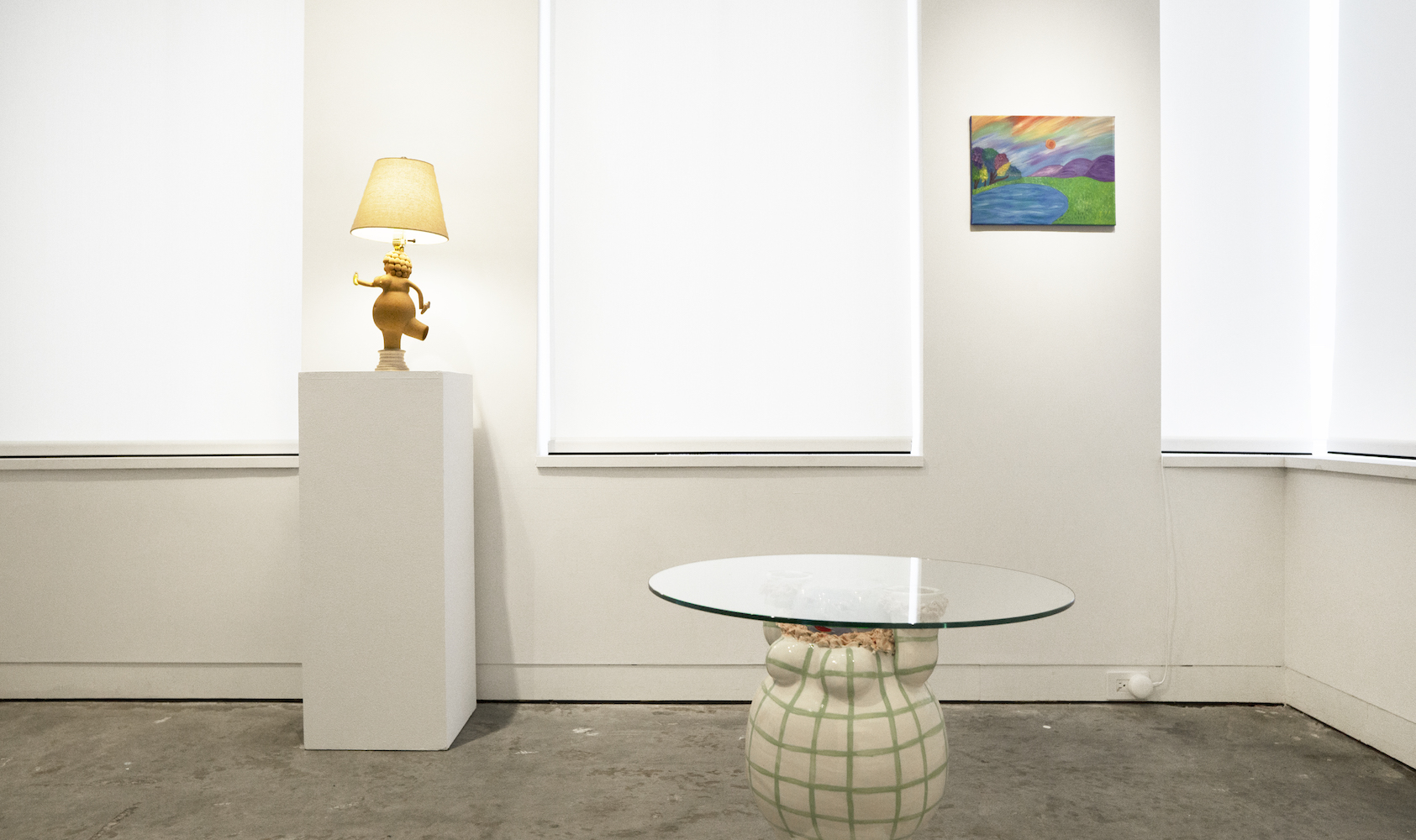 Installation view of Jen Dwyer’s “Garden of Archetypes,” courtesy of the artist and Dinner Gallery, New York.
Installation view of Jen Dwyer’s “Garden of Archetypes,” courtesy of the artist and Dinner Gallery, New York.
WW: What are the different archetypes you explored?
JD: I was thinking about Carl Jung’s archetypes while creating this exhibition. Although there are twelve brand archetypes, there are four main archetypes that make up the human personality which I used as inspiration in my exhibition. They are the persona, the outward face we present to the word, and the Anima, the mirror image of our biological sex, the unconscious masculine side in women or the feminine side in women. I don’t like how binary this archetype is, gender is a spectrum, but I do like how there is a fusing of different energies in this archetype; the Shadow, the animal side of our personality, reflects predispositions that once had survival value and can be both creative and destructive energies, and lastly the self of unity in experience.
WW: The show asks of us, who are we when we are alone and who are we when in public? What kinds of answers might we see?
JD: I read this article a bit ago by Shara Amhed who talked about the idea of ‘Happy Objects’ and this idea that when women grow up they trade in their childhood objects that bring them joy for adulthood objects. While thinking about public and private life/self, I was also thinking about both things I am attracted to, all things shiny & sparkly, and my desire to laugh. However, I am pretty introverted and those that don’t know me well would probably describe me as reserved. And when I was teaching, I would wear a lot of more muted and monochrome attire to context switch from my taste to conform to the environment I was in. Now that I am a full-time artist, what I wear doesn’t really matter, but I think about context switching and assimilating in general.
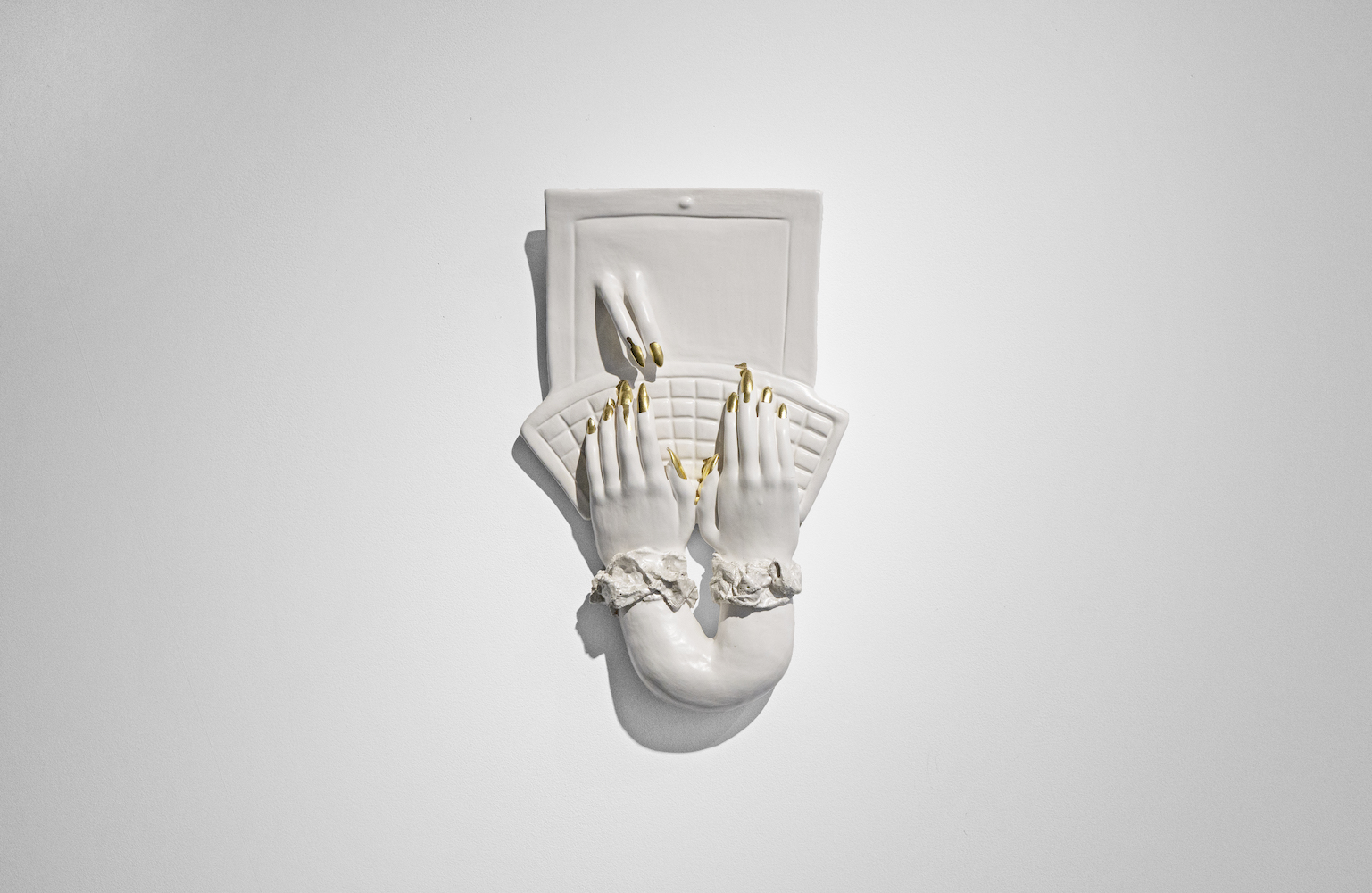 Installation view of Jen Dwyer’s “Garden of Archetypes,” courtesy of the artist and Dinner Gallery, New York.
Installation view of Jen Dwyer’s “Garden of Archetypes,” courtesy of the artist and Dinner Gallery, New York.
WW: Where our private life ends and public life begins has become more and more blurred. What do you think about that division in your own life and practice?
JD: I don’t think there’s much division for better or worse. I have a complicated relationship with social media but at the same time, I’ve made some really close friends through it. When I was going to grad school at the University of Notre Dame in the Midwest I felt like a black sheep in my program, but I was able to connect with different artists from all over who were engaging in conversations I was really interested in. So, I do feel like the blurring of private and public life can lead to deeper connections but I’m sure there’s a flipside to that as well.
WW: In the exhibition, how do you see the paintings and ceramic works in dialogue?
JD: This was the first exhibition where I combined large-scale oil paintings with my ceramic sculptures. The way I see the two working in dialogue is that the sculptures begin the story and the paintings embellish it. The sculptures are the main chapters, but the paintings add the feeling of being in a specific place and setting the stage for a landscape in which the story unfolds. For years I created large-scale installations to house my ceramic sculptures, as I was trying to inspire a certain feeling for my audience, but now I find that paintings can achieve a parallel feeling through my visual language on canvas.
WW: I love the glass-topped tables you’ve created for the show. Can you tell us about those works?
JD: Thanks! I love any kind of cheeky pun so I was thinking about them as ‘glass ceiling table tops’. When making my lady tables, I was thinking about the glass mimicking the paintings or photographs we see of women (there’s space between the viewer and the women in the paintings/photographs—she is an untouchable frozen idealized woman). When constructing my tables, I gave each lady a unique attire and fashion sense to give each lady her own sense of autonomy and agency.
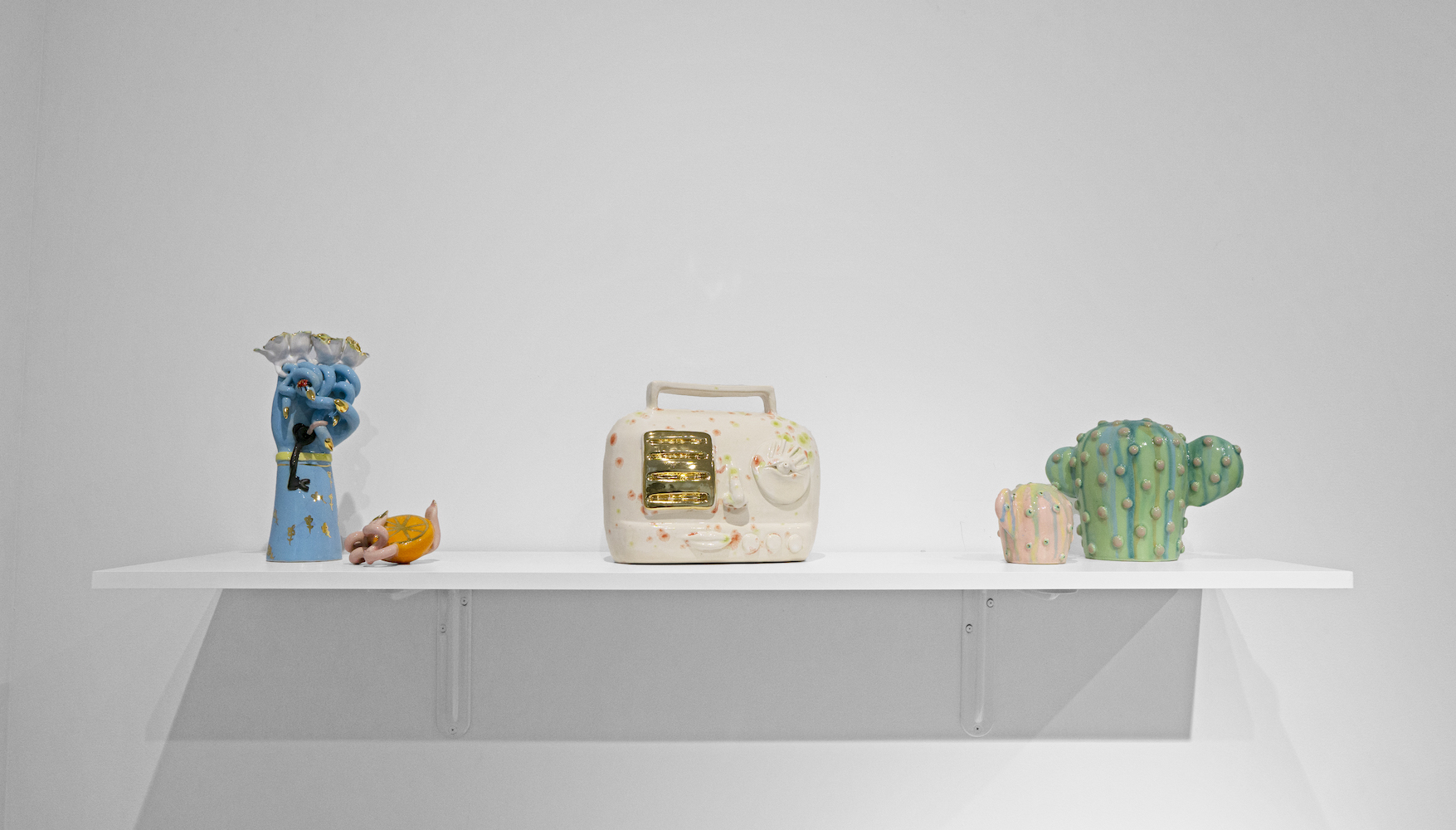 Installation view of Jen Dwyer’s “Garden of Archetypes,” courtesy of the artist and Dinner Gallery, New York.
Installation view of Jen Dwyer’s “Garden of Archetypes,” courtesy of the artist and Dinner Gallery, New York.
WW: We see a recurrence of motifs like the rose, the varnished fingernail, a cowboy hat. What are these symbols representative of for you?
JD: I reference a lot of Greek Mythology in my work. Ancient Greek culture was a very patriarchal culture. Many of the Greek mythologies blamed and shamed women for things that didn’t appear to be their fault—it is Persephone’s fault we have winter because she ate a few pomegranate seeds even though Hades was the one that abducted her. Or, take Medusa for example, who was turned into a monster because Poseidon raped her, yet she was the one that was punished. I use different symbols to represent Greek Mythologies in my work—such as snake-like fingers for Medusa, Roses which were one of Aphrodite’s symbols, among others.
However, the hat, shirt, shoe mirror, and washcloth are all meant to create a vignette of a woman getting ready in the morning.
WW: Was there a piece that started this series or thread of thought for you?
JD: The typewriter, radio, shoe, washcloth, and lamp were the first pieces I made for this show. I started them all around the time last summer/fall when I began to conceptualize the show. Because I like to fill a kiln before firing it, I usually make a handful of sculptures congruently. I was thinking about everyday objects a woman would have in her home and ways to anthropomorphize them to create a surreal liminal or dream-like space.
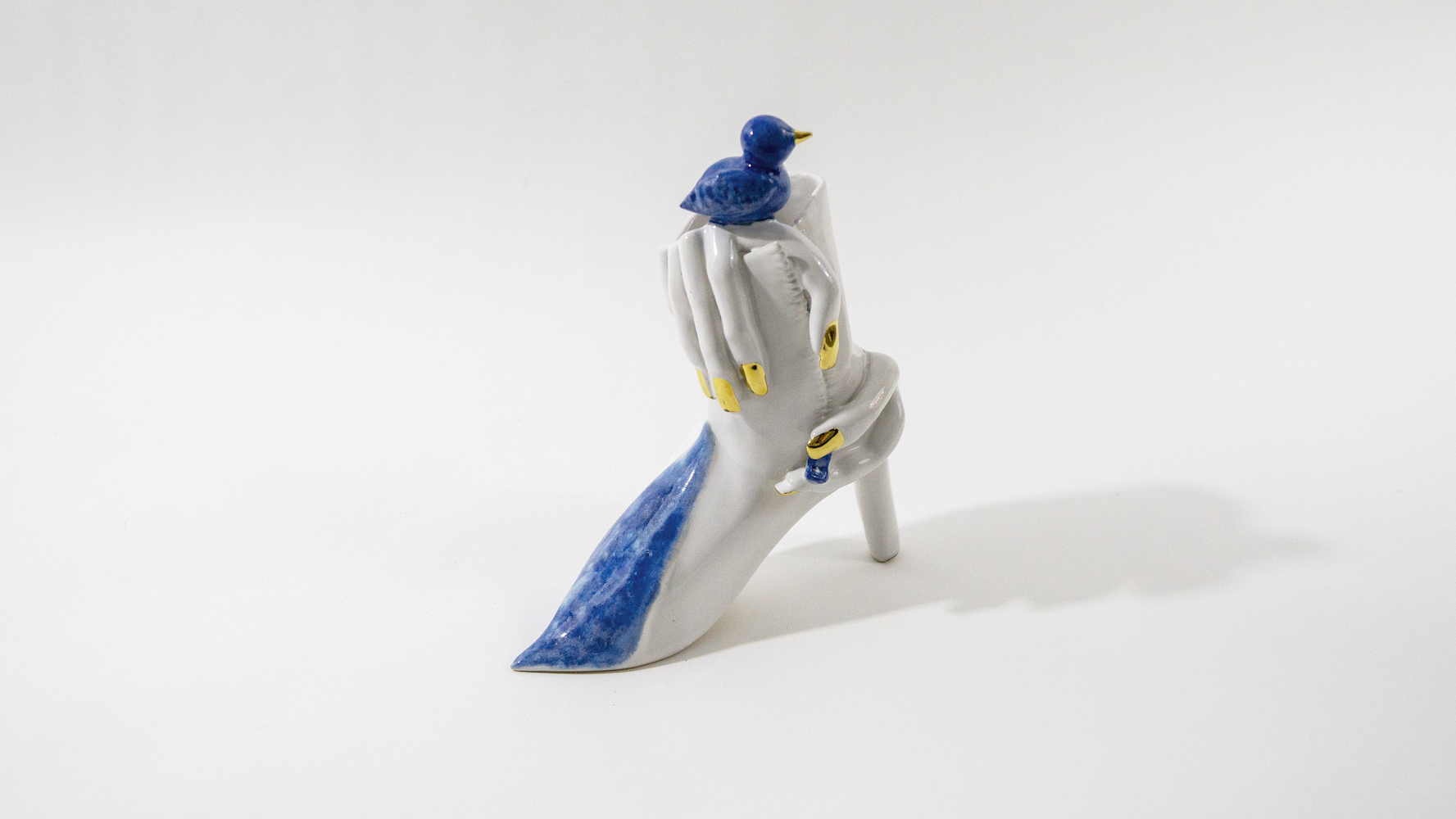 Jen Dwyer, “Whole New Pretend World,” 2021, 8 x 7.5 x 4.5 in, Ceramics, glaze & 24k gold luster; courtesy of the artist and Dinner Gallery, New York.
Jen Dwyer, “Whole New Pretend World,” 2021, 8 x 7.5 x 4.5 in, Ceramics, glaze & 24k gold luster; courtesy of the artist and Dinner Gallery, New York.
WW: And the final piece?
JD: Another thing I hope my viewers take away from the show is a sense of feeling calm and at ease. After so many sad years I was thinking about the ways to create a space that could serve as a tranquil and or peaceful space that my audience could step into and create a bit of a respite or reprieve from the chaos of daily life.
And the idea of “Garden of Archetypes” arose when I was thinking about how it is human nature to want to understand and categorize things, places, and people. But what happens when we give someone a label or title? It can flatten that person to be one-dimensional, when in reality, everyone is complicated with their own unique narrative. So, the title arose from the idea that everyone and I focused on an individual woman, is a Plethora or Garden 😉 of Archetypes, not just one.
 Installation view of Jen Dwyer’s “Garden of Archetypes,” courtesy of the artist and Dinner Gallery, New York.
Installation view of Jen Dwyer’s “Garden of Archetypes,” courtesy of the artist and Dinner Gallery, New York.






